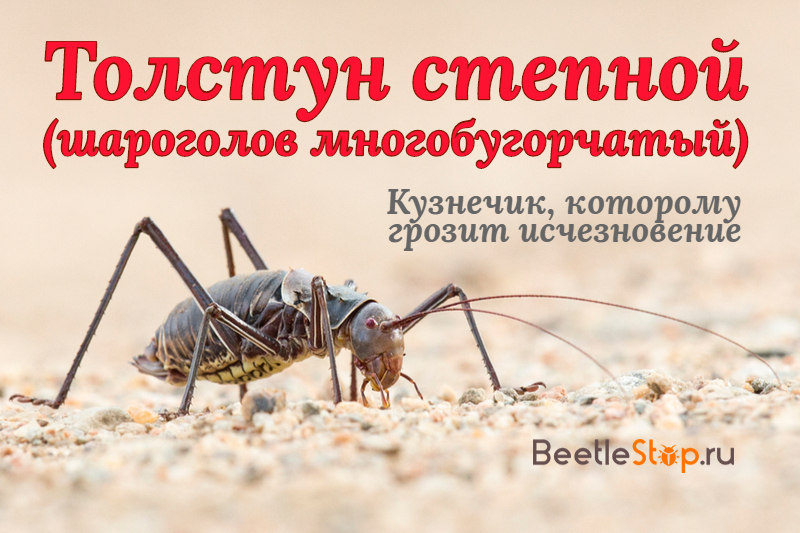Steppe Chubun - An Endangered Grasshopper
In the Black Sea steppe zone, among the forbs and cereals the thicket steppe lives. This is a rare species of grasshopper that is endangered. Large massive insects before the beginning of the 20th century. met in the south of Russia and Ukraine, in the foothills of the Caucasus. The economic activity of people and the plowing of the virgin steppes led to the widespread extinction of the species. The surviving individuals live in the untouched protected areas of the steppe, the number of such places is constantly reduced. Tolstun Steppe was on the European Red List and the Red Book of Russia.

View description
A thicket of the steppe or globola many-tuberous (Bradyporusmultituberculatus) is a representative of the family of true grasshoppers from the order of Orthoptera. The endemic species of the Black Sea has become an extremely rare inhabitant of the steppe fauna. The body of insects is an unusual round shape, the length of the male is 50-80 mm, the female is 40-60 mm. The length of the saber-shaped ovipositor of the female is 14-22 mm. The upper body of the grasshopper is bronze-black, yellow-brown spots merge on the abdomen in two longitudinal stripes. Individuals with spotty and one-color body coloration are found.
Legs walking, large spikes on legs and powerful spurs. The head is spherical in shape, the eyes are well developed. The mouth apparatus is gnawing. Antennae long, bristle-shaped, located below the eyes. The large pronotum has two keels on the sides and four longitudinal convex ribs in the upper part. The insect has no wings; rudimentary elytra hide under the pronotum. The order of orthoptera is characterized by a significant thickening of the hips of the hind legs. The ball-headed limbs are underdeveloped; he cannot jump long distances.
Interesting fact. Small elytra perform the function of a sound apparatus - with their help grasshoppers make chirping sounds. It is noteworthy that the female Bradyporusmultituberculatus also has a stridulatory apparatus, although in other species it is found exclusively in males.
The photo shows that the body of a thicket steppe is reliably protected by strong covers with tubercles. This feature became the reason for the appearance of the name "Sharogolov many-tuberous", which was given to the insect by the Russian natural scientist Grigory Fischer von Waldheim.
Habitat
Studies conducted in the second half of the XIX century. , talk about spreading to the Voronezh region in the north, to the Caucasus in the south and the Volga in the east. After 100 years, the range has declined markedly, in many places the insects have died out. The habitat of the thicket steppe in Rostov Region, Nevinnomyssk (Stavropol Territory), Krasnodar Territory and Kabardino-Balkaria was confirmed. Grasshoppers settle among forbs and sod-grass vegetation.
Lifestyle
Insects prefer rugged terrain where ravines alternate with flat patches. Settle in a dense dense forbs and shrubs, go into floodplain meadows. Males divide the territory among themselves, neighboring plots are located at a distance of 30-50 cm from each other. From dusk until late at night, climbing onto branches of a bush or tall grass, they chatter loudly. Insects do not like heat, they are active in the morning and evening hours.
The imago and their offspring are herbivores, cereals and legumes in the diet, sage, plantain, dandelion, and calf. Thicklings do not hunt, but replenish protein reserves by eating the soft tissues of dead grasshoppers.
Breeding
The mating period is in June. In globose-headed grasshoppers, the number of males and females is approximately the same. With loud chirping, males attract partners. Mating of insects occurs several times. Two weeks after fertilization, the female proceeds to masonry. With her saber-shaped ovipositor, she makes holes in the soil or turf. Eggs are laid in portions of 6-8 pieces. Orthopterans are characterized by incomplete transformation; they have no pupal stage.
The total fertility of the female is 50-70 eggs. Under natural conditions, the development of the embryo is characterized by a diapause of 3 years, in captivity - 5 years. The larva appears in May, in order to become an adult insect it needs 5 molts. In mid-June, there is a neighborhood of adults and larvae of the last age.
Information. Long diapause is due to the periodic increase in the population of many-tuberous thicket.
Security measures
In the XIX century. the steppe thickens flourished throughout the steppe and forest-steppe zone of Russia and Ukraine. Active economic activity led to a critical reduction, and in some cases, the complete destruction of the grasshopper population. Among the limiting factors:
- development and plowing of virgin lands;
- ubiquitous haymaking;
- grazing;
- use of insecticides in the fields.
The extinction of the species required the adoption of strict protective measures. Grasshopper Bradyporusmultituberculatus is listed in the Red Book of Russia and several regions - Rostov, Stavropol, Voronezh. It belongs to category I - the threat of extinction. The insect is protected in Ukraine, is listed in the European Red List.
In 2014 in the Kabardino-Balkarian Republic, a massive appearance of a thicket was recorded. It is seen on the Tersky ridge, where the landscape and turfy-cereal vegetation create optimal conditions for the existence of the species. Dry climate and mountainous terrain have become natural constraints on economic activity. The find makes it possible to retrain the thicket of the steppe from I category to III - a species widespread in a limited area.
As conservation measures for the conservation of the relict species, it is necessary to organize islands of virgin lands with herbs. Natural areas will become a refuge for endangered insects. In such areas it is necessary to prohibit mowing grass, cutting down shrubs, and grazing livestock. In nearby fields, the use of insecticides is limited.

